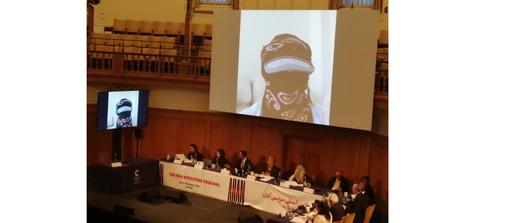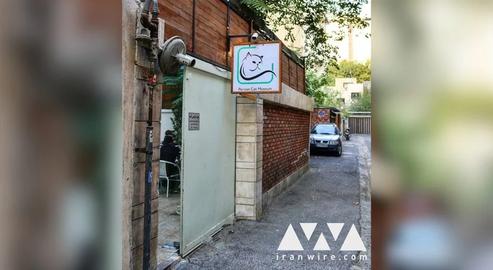An former senior Iranian police officer told the Aban Tribunal on Thursday that he stopped his 60-strong unit from opening fire on protesters in November 2019 – and was then prosecuted for disobeying orders.
Witness 195 appeared via videolink from what was described as “a safe place”. Like many other Iranian witnesses in the tribunal, he covered his face with a bandana and glasses, and his words were delivered to the court second-hand by an intermediary. In November 2019, Witness 195 was a police officer with the rank of Major. Now a five-year prison sentence in Iran hangs over his head.
From Saturday, November 16, Witness 195 and forces under his command were assigned to a zone of one Iranian city in which to keep order. They also had plainclothes officers posted on the corner of the governor’s office, at a branch of Sepah Bank, and overlooking the roof of a major political building. It was on the Monday that they received an explicit command via the walkie-talkie: “The use of firearms is permitted.”
According to their own guidelines, Iranian police are already permitted to use firearms in limited circumstances. There are, Witness 195 explained, proper procedures they are supposed to follow when managing protests, which involve minimizing the use of force. Truncheons are the standard implement if protests absolutely have to be dispersed with “reasonable force”. The call, he said, could therefore have only meant one thing: “Crack down on protests by any means possible. You have to finish it.”
The order was issued by the provincial security council, which is presided over by the governor and also includes representatives of the public prosecutor’s office, military and Basij commanders, the IRGC, the army and the police. “Once an order has come from the provincial security council,” Witness 195 said, “it means no one will face any repercussions.
“I verbally briefed my forces that under any condition, they didn’t have the right to use firearms, and to try to calm the protesters. And fortunately, no problems occurred. The protesters who had gathered were co-operative to the utmost level with the officers, and they were very polite. But in other parts of the city, we could hear Kalashnikovs being fired.”
When law enforcement failed to stop the protests, he said, other forces were deployed. He said he saw individuals in “semi-military” clothing shooting “without any aim or purpose”. Other groups including plainclothes officers, IRGC snipers, the Imam Ali Brigade and army personnel swarmed in and began shooting “blindly, at random” while citizens shouted at the police, “Support us, support us.” An IRGC member of a lower rank then ordered Witness 195 to move his unit to the city’s central boulevard. He refused, he said, “because it’s not part of my job.”
On Monday, November 17, Witness 195 said, there were 15 bodies lying in the morgue of the local hospital.
Two days later, at 9am, he was arrested at work without a warrant and taken to an IRGC intelligence detention center. There, he said, he spent weeks in solitary confinement and was subjected to severe psychological torture. “They’d made up a report from ‘forensic medicine,’ saying my family had had an accident in another city, that their bodies were in the morgue. This was a forged document they’d made. For this reason, I went on a hunger strike. After many weeks they gave me permission to contact my family.”
Now, as a political prisoner, Witness 195 was only allowed to choose his lawyer from a list pre-approved by the judiciary. He was tried in a behind-closed-doors military court in a process that he said lasted just 10 minutes, then sentenced to five years in prison, upheld by the Supreme Court on appeal. The charges were “cooperation and coordination with protesters” and non-compliance with an order from the IRGC.
Pressed by the Aban Tribunal panel on whether the November 2019 protesters had escalated the situation themselves, he said: “People had gathered on the streets peacefully and they were arbitrarily shot by paramilitary forces. There were no problems, but unfortunately someone started to destroy public property, and to set fire to buildings and people’s cars. They tried to cause tension. As a result, these protests then became out of control.” Asked by panel judge Zak Yacoob whether it was true that police officers sometimes set fire to property themselves in order to blame the protesters, he replied: “Yes. I have seen it myself.”
Related coverage:
Aban Tribunal: Shock Day 2 Testimonies Reveal Scope of State Violence
Aban Tribunal: Detainees 'Drugged and Made to Simulate Their Funerals'
Aban Tribunal: Iranians Testify on November 2019 Atrocities in London
The Names of All 133 Officials Accused of November 2019 Crimes
Hundreds Testify in "People's Tribunal" on November 2019 Atrocities
Aban Tribunal: 133 Iranian Officials Accused of November 2019 Crimes
visit the accountability section
In this section of Iran Wire, you can contact the officials and launch your campaign for various problems


























comments